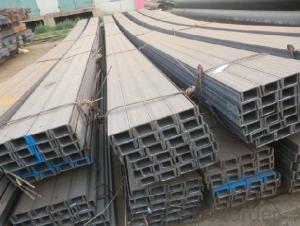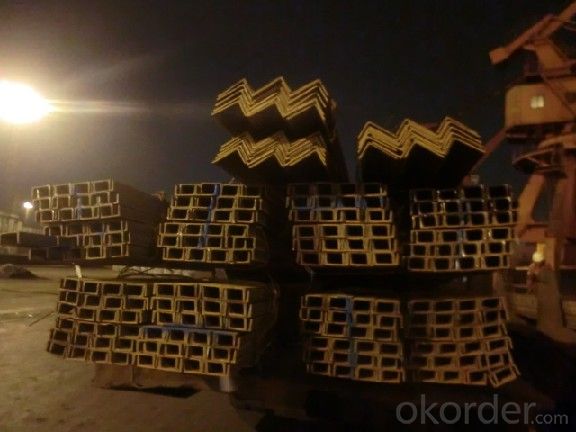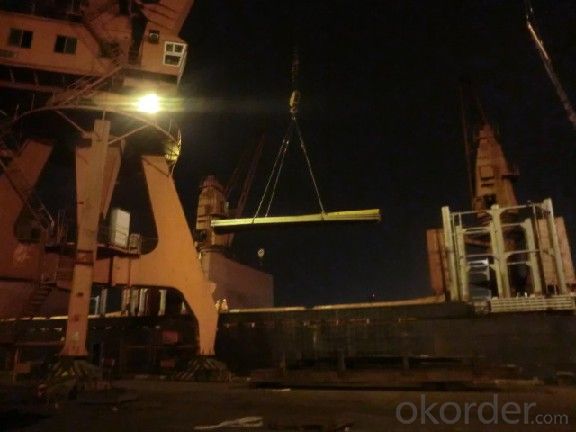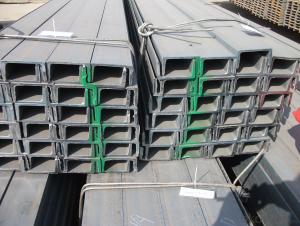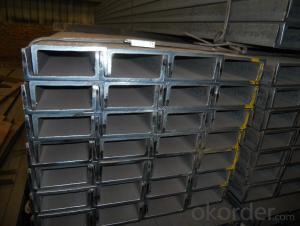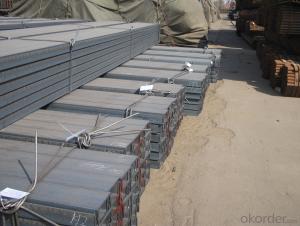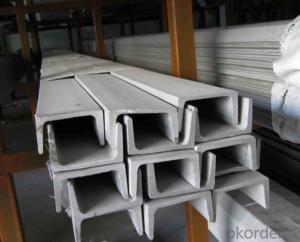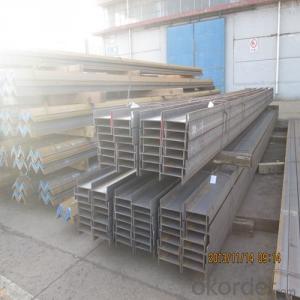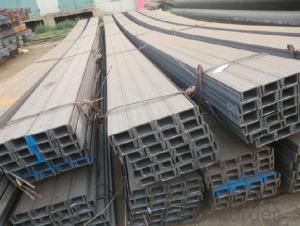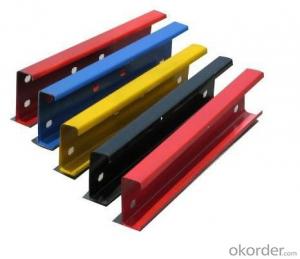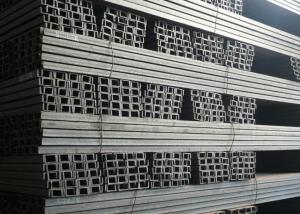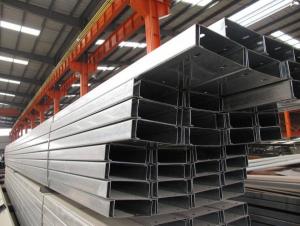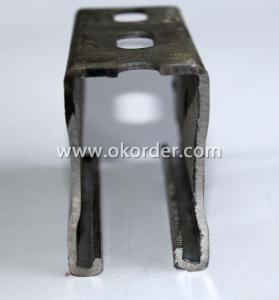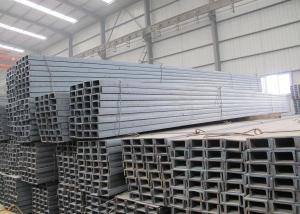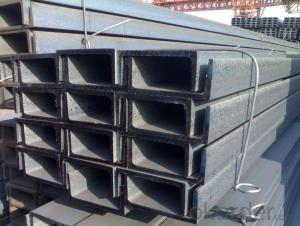Hot Rolled Steel U-Channel High Quality JIS/GB
- Loading Port:
- Tianjin
- Payment Terms:
- TT OR LC
- Min Order Qty:
- 50 m.t.
- Supply Capability:
- 10000 m.t./month
OKorder Service Pledge
OKorder Financial Service
You Might Also Like
Specification
Product Description:
OKorder is offering Hot Rolled Steel U-Channel High Quality JIS/GB at great prices with worldwide shipping. Our supplier is a world-class manufacturer of steel, with our products utilized the world over. OKorder annually supplies products to European, North American and Asian markets. We provide quotations within 24 hours of receiving an inquiry and guarantee competitive prices.
Product Applications:
Hot Rolled Steel U-Channel High Quality JIS/GB are ideal for structural applications and are widely used in the construction of buildings and bridges, and the manufacturing, petrochemical, and transportation industries.
Product Advantages:
OKorder's Hot Rolled Steel U-Channel High Quality JIS/GB are durable, strong, and resist corrosion.
Main Product Features:
· Premium quality
· Prompt delivery & seaworthy packing (30 days after receiving deposit)
· Corrosion resistance
· Can be recycled and reused
· Mill test certification
· Professional Service
· Competitive pricing
Product Specifications:
JIS U CHANNEL | Standard h | Sectional b | Dimension s | t | Mass: Kg/m |
| (mm) | (mm) | (mm) | (mm) |
|
50x25 | 50 | 25 | 3.0 | 6.00 | 2.37 |
75X40 | 75 | 40 | 3.8 | 7.00 | 5.30 |
75X40 | 75 | 40 | 4.0 | 7.00 | 5.60 |
75X40 | 75 | 40 | 4.5 | 7.00 | 5.85 |
75X40 | 75 | 40 | 5.0 | 7.00 | 6.92 |
|
|
|
|
|
|
100X50 | 100 | 50 | 3.8 | 6.00 | 7.30 |
100X50 | 100 | 50 | 4.2 | 6.00 | 8.03 |
100X50 | 100 | 50 | 4.5 | 7.50 | 8.97 |
100X50 | 100 | 50 | 5.0 | 7.50 | 9.36 |
|
|
|
|
|
|
125X65 | 125 | 65 | 5.2 | 6.80 | 11.66 |
125X65 | 125 | 65 | 5.3 | 6.80 | 12.17 |
125X65 | 125 | 65 | 5.5 | 8.00 | 12.91 |
125X65 | 125 | 65 | 6.0 | 8.00 | 13.40 |
|
|
|
|
|
|
150x75 | 150 | 75 | 5.5 | 7.30 | 14.66 |
150x75 | 150 | 75 | 5.7 | 10.00 | 16.71 |
150x75 | 150 | 75 | 6.0 | 10.00 | 17.90 |
150x75 | 150 | 75 | 6.5 | 10.00 | 18.60 |
150x75 | 150 | 75 | 6.5 | 10.00 | 24.00 |
|
|
|
|
|
|
200X80 | 200 | 80 | 7.5 | 11.00 | 24.60 |
Usage of JIS Channel Steel:
1.The JIS Channel Steel can be devided into two kinds, namely common channel steel and light channel steel. The sizes of hot rolled common channel steel range from 5# to 40#. Meanwhile, the channel steel can be divided into cold forming sectional equal channel steel, cold forming sectional unequal channel steel, cold forming inner edge channel steel and outer edge channel steel.
2.The steel u channel is usually used for arch-itechtural structure, and they could be welded in order to support or hang a vari-ety of facilities. They are also usually used in combination with I beam. The channel steel with sizes under 14# is usually applied to construction engineering, as purline, while the channel steel with sizes above 16# is more likely to be used in building vehicle chassis structure and mechanical structure. Furthermore, the channel steel in sizes above 30# are target at building bridge structure, as tension bar.
3.In a word, the channel steel must possess perfect welding property, riveting property and mechanical property and so on.
Applications of MS Channel:
The MS Channel can be applied to construction of warehouses, workshops, sport stadiums and car parks etc.The hot rolled channel steel belongs to carbon structural steel which is applied to in the field of construction and machinery.In details, the hot rolled channel steel is usually used for arch-itechtural structure, and they could be welded in order to support or hang a vari-ety of facilities. They are also usually used in combination with I beam. Generally,the hot rolled channel steel we supply must possess perfect welding property, riveting property and mechanical property and so on.
Package & Delivery of MS Channel:
1.The hot rolled channel steel will be packed in bundle with steel wire at each end of every bundle and color marking in order to help the customer to recognize his goods more easily at sight.
2. And the hot rolled channel steel could be loaded into 20ft or 40ft container, or by bulk cargo.If the weight of each bundle reaches more than 3.5 mt, the loading by break bulk cargo should be choosed.When the weight of each bundle reaches less than 3mt, the loading by container should be choosed.
3.As for the transportaion from mill to loading port, the truck will be usually used. And the maximum quantity for each truck is 40mt.
4.All in all, we could do in accordance with customer's request.
FAQ:
Q1: Why buy Materials & Equipment from OKorder.com?
A1: All products offered byOKorder.com are carefully selected from China's most reliable manufacturing enterprises. Through its ISO certifications, OKorder.com adheres to the highest standards and a commitment to supply chain safety and customer satisfaction.
Q2: How do we guarantee the quality of our products?
A2: We have established an advanced quality management system which conducts strict quality tests at every step, from raw materials to the final product. At the same time, we provide extensive follow-up service assurances as required.
Q3: How soon can we receive the product after purchase?
A3: Within three days of placing an order, we will begin production. The specific shipping date is dependent upon international and government factors, but is typically 7 to 10 workdays.
Q4: What makes stainless steel stainless?
A4: Stainless steel must contain at least 10.5 % chromium. It is this element that reacts with the oxygen in the air to form a complex chrome-oxide surface layer that is invisible but strong enough to prevent further oxygen from "staining" (rusting) the surface. Higher levels of chromium and the addition of other alloying elements such as nickel and molybdenum enhance this surface layer and improve the corrosion resistance of the stainless material.
Q5: Can stainless steel rust?
A5: Stainless does not "rust" as you think of regular steel rusting with a red oxide on the surface that flakes off. If you see red rust it is probably due to some iron particles that have contaminated the surface of the stainless steel and it is these iron particles that are rusting. Look at the source of the rusting and see if you can remove it from the surface.
Images:
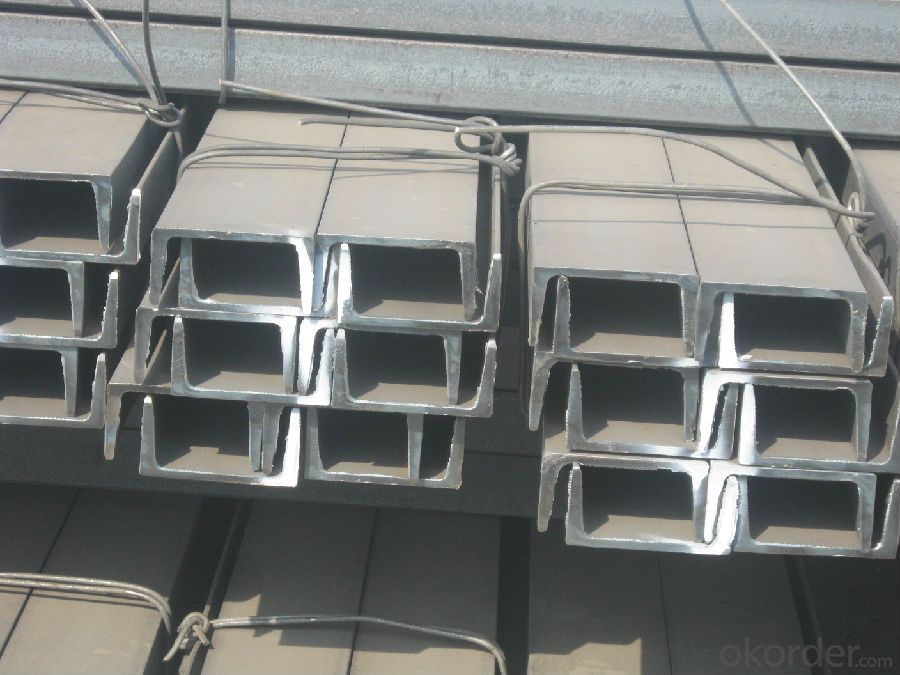
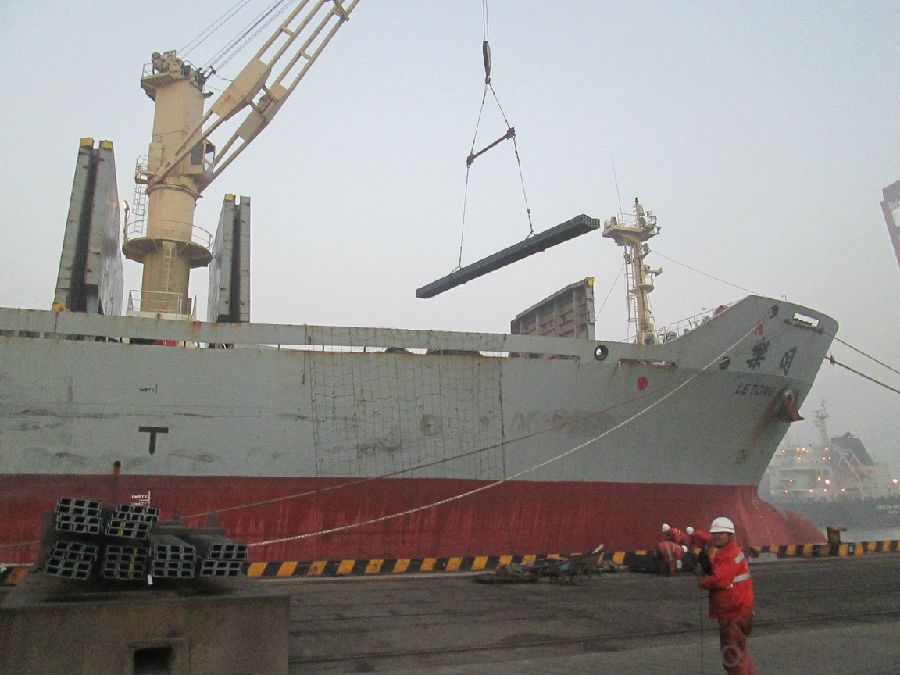
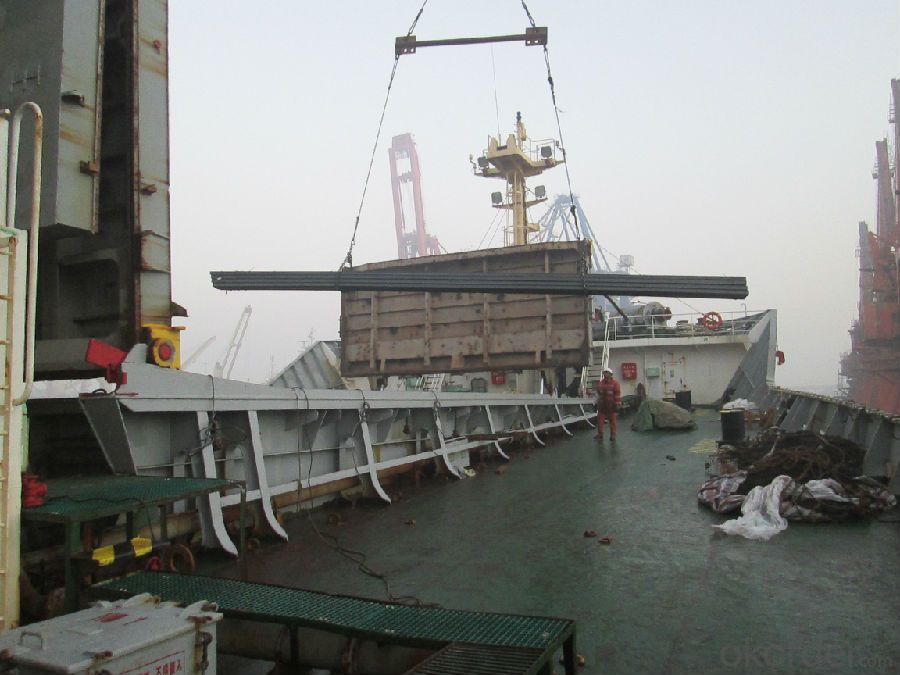
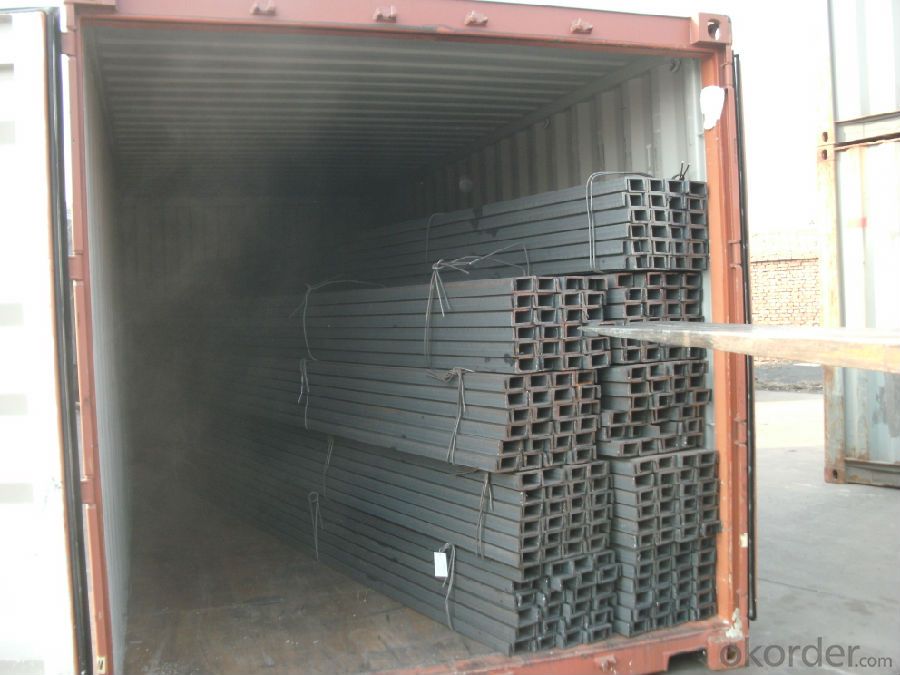
- Q: Are steel channels suitable for modular partition systems?
- Yes, steel channels are suitable for modular partition systems. Steel channels provide structural strength and stability required for modular partitions, allowing for easy installation and customization. They also offer durability and can withstand the weight of partition panels, ensuring long-lasting performance. Additionally, steel channels can be easily integrated with other components of the partition system, making them a suitable choice for modular applications.
- Q: Can steel channels be used for machinery framing?
- Yes, steel channels can be used for machinery framing. Steel channels provide structural support and stability, making them suitable for framing machinery and equipment. They have high strength, durability, and can withstand heavy loads, making them an ideal choice for machinery framing applications.
- Q: How do steel channels contribute to the overall sustainability of the construction industry?
- The construction industry benefits greatly from the use of steel channels, as they contribute to sustainability in several important ways. Firstly, the longevity and durability of steel make it an ideal construction material, resulting in structures that have a longer lifespan compared to other materials. This reduces the need for frequent repairs or replacements, leading to less waste and a lower environmental impact. In addition, steel is highly recyclable. When a structure made with steel channels reaches the end of its life, the steel can be easily salvaged and repurposed for new products. This reduces the demand for new steel production, which is an energy-intensive and environmentally harmful process. By recycling steel, we also conserve natural resources and decrease greenhouse gas emissions associated with mining and extracting raw materials. Furthermore, the ability to prefabricate steel channels offsite offers several sustainability advantages. Prefabrication allows for more precise and efficient construction, minimizing waste and reducing overall construction time. This not only reduces the environmental impact but also saves energy and resources. Moreover, steel's lightweight properties mean that structures built with steel channels require less foundation and support compared to heavier materials. This reduces the amount of concrete and other materials needed for construction, resulting in lower carbon emissions and less waste. Lastly, steel channels contribute to energy efficiency in buildings. Steel has excellent thermal conductivity, enabling efficient heating and cooling systems. This can lead to reduced energy consumption and lower greenhouse gas emissions, ultimately contributing to a more sustainable built environment. In conclusion, steel channels play a vital role in promoting sustainability within the construction industry. Their durability, recyclability, prefabrication potential, lightweight nature, and energy-efficient properties all contribute to reducing waste, conserving resources, and minimizing environmental impact.
- Q: What are the advantages of using steel channels in construction?
- One advantage of using steel channels in construction is their strength and durability. Steel channels are able to withstand heavy loads and provide structural support, making them ideal for use in building frameworks and structural systems. Additionally, steel channels have a high resistance to corrosion, which increases their lifespan and reduces the need for maintenance. Furthermore, steel channels can be easily fabricated and installed, allowing for efficient construction processes. Overall, the use of steel channels in construction offers superior strength, durability, and ease of installation, making them a preferred choice in many building projects.
- Q: What are the different methods of strengthening steel channels against bending?
- There are several methods of strengthening steel channels against bending. One common method is to add additional material, such as angle iron or flat bars, to the flanges of the channel to increase their rigidity. Another approach is to increase the thickness of the channel itself, which helps to resist bending forces. Additionally, using bracing techniques, such as adding diagonal supports or cross-members, can enhance the overall strength and stability of the steel channel. Welding stiffeners or gussets to critical areas of the channel can also provide reinforcement against bending. Ultimately, the specific method chosen depends on the intended use and the level of bending resistance required for the steel channel.
- Q: Can steel channels be used in architectural facades?
- Yes, steel channels can be used in architectural facades. Steel channels are versatile and durable, making them suitable for various architectural applications, including facades. They can be used to create a modern and sleek aesthetic, or to add structural support to the facade. Steel channels can be easily fabricated and customized to meet the specific design requirements of the facade, allowing for a wide range of possibilities in terms of shape, size, and finish. Additionally, steel channels provide excellent strength and stability, making them capable of withstanding the environmental stresses and loads typically encountered in architectural facades.
- Q: How are steel channels used in the construction of warehouses?
- Steel channels are commonly used in the construction of warehouses to provide structural support. They are used as beams or columns to bear heavy loads and distribute weight evenly throughout the structure. Steel channels also help in creating strong and stable frames, allowing for the construction of large and open spaces within the warehouse. Additionally, they can be used for bracing, reinforcing walls, and supporting overhead doors. Overall, steel channels play a crucial role in ensuring the stability and durability of warehouse structures.
- Q: What are the common safety considerations in the design of steel channels?
- When designing steel channels, there are several common safety considerations that need to be taken into account to ensure the overall safety and structural integrity of the channels. These considerations include: 1. Load-bearing capacity: One of the primary safety concerns is ensuring that the steel channels have sufficient load-bearing capacity to support the intended loads. This involves analyzing the expected loads, such as the weight of the materials or equipment that will be placed on the channels, and designing the channels with adequate strength and stiffness to withstand these loads without failure. 2. Material selection: The choice of material for the steel channels is another important safety consideration. The material should have the necessary strength and durability to withstand the anticipated loads, as well as resistance to corrosion, fire, and other potential hazards. The material should also meet the relevant industry standards and specifications. 3. Structural stability: The design of steel channels should ensure their structural stability, which involves considerations such as the proper sizing and positioning of the channels, the use of appropriate connections, and the incorporation of bracing or other reinforcement elements if needed. Structural stability is crucial to prevent buckling, collapse, or other forms of failure under load. 4. Fire resistance: In certain applications, fire resistance is a critical safety consideration for steel channels. Depending on the location and purpose of the channels, they may need to be designed to withstand high temperatures and prevent the spread of fire. This can involve using fire-resistant coatings or insulation materials and designing for proper ventilation to prevent the buildup of heat. 5. Accessibility and ergonomics: Safety considerations also extend to the accessibility and ergonomics of the steel channels, especially in industrial or construction settings. Designers should ensure that the channels are easily accessible for installation, inspection, and maintenance tasks, and that they are designed to minimize potential hazards or risks to workers who may interact with them. 6. Compliance with codes and regulations: Finally, it is essential to consider the relevant codes, standards, and regulations when designing steel channels. Compliance with these requirements ensures that the channels meet the necessary safety standards and are fit for their intended purpose. By addressing these common safety considerations in the design of steel channels, engineers and designers can create structures that are safe, reliable, and able to withstand the intended loads and environmental conditions.
- Q: Can steel channels be used for both residential and commercial applications?
- Yes, steel channels can be used for both residential and commercial applications. Steel channels are versatile and durable structural components that can be used in various construction projects. In residential applications, steel channels can be used for framing walls, supporting ceilings, and creating structural supports for staircases and balconies. They are also commonly used in commercial applications such as in the construction of warehouses, factories, and office buildings. Steel channels provide excellent strength and load-bearing capacity, making them suitable for both residential and commercial projects of various sizes and complexities. Additionally, steel channels are highly resistant to corrosion and fire, further enhancing their suitability for both types of applications.
- Q: Can steel channels be used in multi-story buildings?
- Multi-story buildings can indeed utilize steel channels. These steel channels, also referred to as C-channels or structural channels, are commonly employed in construction due to their robustness and endurance. They offer structural reinforcement and are frequently employed as framing components in numerous applications, including multi-story buildings. Steel channels possess a combination of lightweight and strength, rendering them ideal for multi-story buildings where weight plays a critical role. Their fabrication and installation are simple, which reduces construction time and expenses. Furthermore, steel channels exhibit excellent resistance to fire, corrosion, and other environmental factors, ensuring the long-term stability and safety of the building. Within multi-story buildings, steel channels can be employed as beams, columns, or bracing elements to distribute the load and provide stability. They can withstand the weight of floors, walls, and roofs, while also enduring dynamic forces such as wind and seismic loads. Through meticulous engineering and design considerations, steel channels can efficiently manage the vertical and horizontal loads that arise in multi-story buildings. Moreover, steel channels can seamlessly integrate with other structural systems, such as steel frames or reinforced concrete, to establish a sturdy and adaptable building structure. Their versatility allows for a broad range of design possibilities, accommodating different architectural styles and functional requirements. In conclusion, steel channels are a suitable option for multi-story buildings due to their strength, durability, and versatility. They offer structural support, resist environmental factors, and can be easily integrated into the building's framework.
Send your message to us
Hot Rolled Steel U-Channel High Quality JIS/GB
- Loading Port:
- Tianjin
- Payment Terms:
- TT OR LC
- Min Order Qty:
- 50 m.t.
- Supply Capability:
- 10000 m.t./month
OKorder Service Pledge
OKorder Financial Service
Similar products
Hot products
Hot Searches
Related keywords
